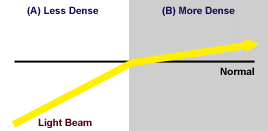How does light bend if it is going from an object with a higher density through an object with a lower density?
1 Answer
Jan 3, 2017
Snell's law relates the indices of refraction for two media with their angles of refraction with respect to the normal, and states:
#n_1sintheta_1 = n_2sintheta_2# where:
#n_i# is the index of refraction of medium#i# .#theta_i# is the angle of refraction (with respect to the normal of the boundary line) in medium#i# .
A denser medium has a higher index of refraction.
Let
Therefore,


